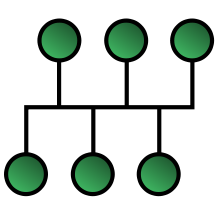Difference between revisions of "Network Topology"
| Line 1: | Line 1: | ||
| − | ==Star | + | ==Star Topology== |
Nodes are connected to a host computer or hub that controls communication between devices. the hub or host computer regenerates any signal that it receives and passes it on. Only the intended recipient computer acts on the message. | Nodes are connected to a host computer or hub that controls communication between devices. the hub or host computer regenerates any signal that it receives and passes it on. Only the intended recipient computer acts on the message. | ||
| Line 17: | Line 17: | ||
* It requires a lot of cables. | * It requires a lot of cables. | ||
* It is expensive to install | * It is expensive to install | ||
| + | |||
| + | ==Bus Topology== | ||
| + | [[File:BusNetwork svg.png]] | ||
Revision as of 14:10, 15 December 2016
Contents
Star Topology
Nodes are connected to a host computer or hub that controls communication between devices. the hub or host computer regenerates any signal that it receives and passes it on. Only the intended recipient computer acts on the message.
All nodes have independent connections to the host. A cable failure on one branch of the network will continue to function normally and the failure will be easy to isolate.
The advantages are that:
- Adding new devices is easy and doesn't disrupt the rest of the network.
- There are no data collisions.
- There is less traffic on the network.
- A cable failure on one branch of the network will be easy to isolate.
The disadvantages are that:
- It requires a lot of cables.
- It is expensive to install

